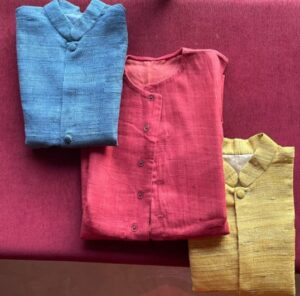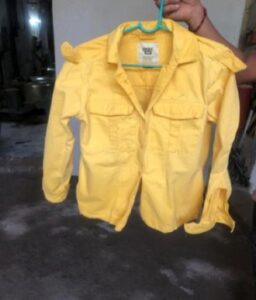Following Natural dyeing Activities have been developed in BTRA
We are ready to help Textile companies to develop Sustainable Natural dyeing units through consultation and product development.
- Natural dyeing processes developed for large number of natural dyes(16) namely-Maddar, Indigo, Lac, Rheum, Pomergranate, Leafy green, Yeliona, Red sandalwood, Heena, Myrobalan, Annatto, Catechu, Turmeric, Sappanwood, Walnut, and Eupatorium.
- Natural dyeing process developed for different Natural and Synthetic fabrics-Cotton, Jute, Linen, Silk, Wool, Viscose, Polyester
- Natural dyeing methods developed using primarily Natural mordants and auxiliaries
- Room temperature natural dyeing to save energy
- Brilliant coloration to fabrics with high K/S and CIELab values
We are ready to help Textile companies to develop Sustainable Natural dyeing units through consultation and product development.
Sustainable Natural Dyeing of Garment with Natural Rare earth salts
Padma Shree Vankar* and Afreen Begum BTRA, Mumbai
Abstract:
Sustainable Garment dyeing using natural dyes have been attained by augmenting with natural rare earth salts as mordants replacing the conventional mordants. This could be achieved using different dyeing techniques. Apart from exhaust dyeing, Foam dyeing and spray dyeing techniques were attempted. All the techniques yielded even dyeing and good fastness properties.
Key words: Sustainable natural dyeing, Rare earth salts, Exhaust dyeing, Foam dyeing, Spray dyeing
Introduction: Garment dyeing has become an increasingly important part of dyeing industry in the recent years. There has been a significant growth in the demand of Garment dyeing due to rapid fashion response. There are several advantages in switching over to garment dyeing. We have attempted to do garment dyeing with natural dyes using different techniques. All of them have yielded very good results in terms of evenness of natural dyeing and fastness properties of the dyed garments. In our case we have used rare earth salts as mordants with natural dyes.
VERSATILITY of Rare Earth salts
Eco-friendly Natural Dyeing of natural fabrics such as Cotton, Silk as well as synthetic fabric like Polyester and semi synthetic fabric viscose using Rare Earths Metal Salts as Mordants by replacing traditional metal mordants. We have carried out natural dyeing of these fabrics using nonconventional mordant salt. These nonconventional mordant are rare earth salt (RE salt) namely- Cerous sulphate, Lanthanum chloride and Yttrium chloride. It is for the first time that these rare earth salts have been used in the natural dyeing process.
COMPATABILITY of Rare Earth salts
The high coordination capability of the rare earth metal has been the cause of better dye uptake. Different natural dyes have been demonstrated to show better dyeing results with RE salt as compared to conventional mordants. Even the quantity of rare earth mordant required to get desired results is 1/10th quantity of the conventional mordants, thereby directing towards lesser effluent load. Thus the use of rare earth mordant has good prospects in the Natural dyeing of these fabrics. Natural dyeing of Polyester and viscose fabric is quite challenging. Since the polyester fabric has an inherent hydrophobic character the dye uptake under conventional method is very poor for Natural colorants. Dyeing of cotton and silk fabrics were dyed with 14 natural dyes- namely Indigo, Maddar, Rheum, Punica, Lac, Leafy green, Henna, Yeliona, Myrobalan, Red Sandal, Walnut, Eupatorium, Turmeric and Catechu using all the three RE salts mainly to check the dye compatibility with the RE salt and also to demonstrate the improvement in dye uptake by the use of the one RE salt. Each of the natural dye showed unique reactivity towards a particular RE salt. Figure-1 shows garments dyed by Natural dyes- Indigo, Maddar and Yeliona.
Key words: Sustainable natural dyeing, Rare earth salts, Exhaust dyeing, Foam dyeing, Spray dyeing
Introduction: Garment dyeing has become an increasingly important part of dyeing industry in the recent years. There has been a significant growth in the demand of Garment dyeing due to rapid fashion response. There are several advantages in switching over to garment dyeing. We have attempted to do garment dyeing with natural dyes using different techniques. All of them have yielded very good results in terms of evenness of natural dyeing and fastness properties of the dyed garments. In our case we have used rare earth salts as mordants with natural dyes.
VERSATILITY of Rare Earth salts
Eco-friendly Natural Dyeing of natural fabrics such as Cotton, Silk as well as synthetic fabric like Polyester and semi synthetic fabric viscose using Rare Earths Metal Salts as Mordants by replacing traditional metal mordants. We have carried out natural dyeing of these fabrics using nonconventional mordant salt. These nonconventional mordant are rare earth salt (RE salt) namely- Cerous sulphate, Lanthanum chloride and Yttrium chloride. It is for the first time that these rare earth salts have been used in the natural dyeing process.
COMPATABILITY of Rare Earth salts
The high coordination capability of the rare earth metal has been the cause of better dye uptake. Different natural dyes have been demonstrated to show better dyeing results with RE salt as compared to conventional mordants. Even the quantity of rare earth mordant required to get desired results is 1/10th quantity of the conventional mordants, thereby directing towards lesser effluent load. Thus the use of rare earth mordant has good prospects in the Natural dyeing of these fabrics. Natural dyeing of Polyester and viscose fabric is quite challenging. Since the polyester fabric has an inherent hydrophobic character the dye uptake under conventional method is very poor for Natural colorants. Dyeing of cotton and silk fabrics were dyed with 14 natural dyes- namely Indigo, Maddar, Rheum, Punica, Lac, Leafy green, Henna, Yeliona, Myrobalan, Red Sandal, Walnut, Eupatorium, Turmeric and Catechu using all the three RE salts mainly to check the dye compatibility with the RE salt and also to demonstrate the improvement in dye uptake by the use of the one RE salt. Each of the natural dye showed unique reactivity towards a particular RE salt. Figure-1 shows garments dyed by Natural dyes- Indigo, Maddar and Yeliona.

SUSTAINABILITY with Rare Earth salts
In order to prove the aspect of sustainability of Rare earth salts which have been used as mordants in natural dyeing, the toxic index was evaluated by us. We were interested to find out the traces of RE salts on the fabric as well as on effluents.
Cerium salt mordanted with 1 % owf for cotton fabric showed the following results:
Toxic Index study for Rare earth salt mordants
Cotton dyed fabric treated by Cerium salt (when we used 1 %mordant solution)
In order to prove the aspect of sustainability of Rare earth salts which have been used as mordants in natural dyeing, the toxic index was evaluated by us. We were interested to find out the traces of RE salts on the fabric as well as on effluents.
Cerium salt mordanted with 1 % owf for cotton fabric showed the following results:
Toxic Index study for Rare earth salt mordants
Cotton dyed fabric treated by Cerium salt (when we used 1 %mordant solution)
- Total digestion method analysed by Method– DIN EN 1671-I is 313.9.mg/kg.
- Perspiration method analysed by Method –DIN EN 16711-II is 0.558 mg/kg.
Dye Effluent analysis showed the following results:
Now we are using only 0.4 % mordant solution of Rare earth salts
We can definitely use rare earth metal mordants safely during natural dyeing of fabrics and garments. This makes natural dyeing sustainable and safe for both human beings and environment.
Sustainable Natural dyeing of Garments
1. Exhaust dyeing: Exhaust dyeing of jacket has been carried out using madder dye along with RE salts as shown in figure 1. Exhaust dyeing is a method of dyeing a textile material or garment. The method involves the gradual transfer of dye from a dye bath to the textile material in the same piece of equipment. In Exhaust dyeing, it is the ability of the dye molecules to move from the solution onto the fabric fibers due to its affinity for the fiber. The affinity of a dye can be influenced by temperature or additives, such as mordants. In our case we have used RE salts as shown in figure-2 and 3.
Now we are using only 0.4 % mordant solution of Rare earth salts
- Total Cerium content in the used mordant solution is 1.09 mg/kg
- Total Yttrium content in the used mordant solution is 0.78 mg/kg
We can definitely use rare earth metal mordants safely during natural dyeing of fabrics and garments. This makes natural dyeing sustainable and safe for both human beings and environment.
Sustainable Natural dyeing of Garments
1. Exhaust dyeing: Exhaust dyeing of jacket has been carried out using madder dye along with RE salts as shown in figure 1. Exhaust dyeing is a method of dyeing a textile material or garment. The method involves the gradual transfer of dye from a dye bath to the textile material in the same piece of equipment. In Exhaust dyeing, it is the ability of the dye molecules to move from the solution onto the fabric fibers due to its affinity for the fiber. The affinity of a dye can be influenced by temperature or additives, such as mordants. In our case we have used RE salts as shown in figure-2 and 3.


The Spray dye process radically reduces the environmental profile of the color application process while improving the use phase performance of the finished fabric. By removing the requirement of water at the point of color application, Because traditional processes require considerable energy to heat the water and dry the fabric, Spray dye technology also significantly reduces the energy required at the point of color application. As Spray dye technology matures, expect to see additional benefits from increased efficiency in power usage, power source, and the direct application of dye without a donor media. Spray dye is a clear response to an increasing awareness of the environmental impacts associated with traditional dye application processes and a new technology for improving the process of coloration and decoration of textiles. Figure-4 shows denim jacket spray dyed by Indigo.
Conclusion: Garment dyeing with natural dyes using rare earth mordants has given very good results. Exhaust dyeing, Foam dyeing and Spray dyeing techniques were adapted for different natural dyes which yielded in even dyeing despite the fabric construction, sewing thread, buttons, zippers, jacket lining etc., dyeing process and the machine used for dyeing helped us to achieve uniform dyeing and good fastness properties of the dyed garments.
Conclusion: Garment dyeing with natural dyes using rare earth mordants has given very good results. Exhaust dyeing, Foam dyeing and Spray dyeing techniques were adapted for different natural dyes which yielded in even dyeing despite the fabric construction, sewing thread, buttons, zippers, jacket lining etc., dyeing process and the machine used for dyeing helped us to achieve uniform dyeing and good fastness properties of the dyed garments.


